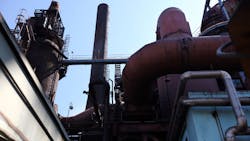“It has been a tough year for the steel industry,” Tom Gibson, the president and CEO of the American Iron and Steel Institute, told reporters in a conference call last November. In fact, while global steel production fell 2.8% in 2015, steel output in the U.S. plummeted by 10.5%.
Earlier that day, Gibson and leading steel executives had met with Obama administration officials to “impress on them the urgency of the crisis” and urge them to use all the tools at their disposal to fight against the dumping of cheap steel into the U.S.
There is no mystery as to the main causes of this crisis. Falling oil prices have put the brakes on drilling and other investments by the oil and gas industry, a major customer of the steel companies. And China, the world leader in steel production, is in the midst of a wrenching slowdown in its economy. But China, like many developing economies, is invested in seeing its domestic steelmaking capacity grow. So despite historic excess capacity in the market, China, India and other nations provide subsidies to their steelmakers so they can keep churning out the steel.
The Organization for Economic Co-operation and Development estimates that there is overcapacity in the global steel industry of 700 million metric tons. More than half of that – 425 million tons - comes from China. The only way to solve this overcapacity issue, says John Ferriola, CEO of Nucor, is to remove government support by China and other nations and “allow basic market forces to determine industry outcome.”
For now, however, production capacity is headed in the wrong direction. “Global nominal steelmaking capacity is projected to increase to 2.36 billion tonnes by 2017, up from 2.16 billion tonnes in 2013,” OECD forecast in a 2015 report. “Non-OECD economies will continue to lead the capacity expansion in the global steel industry, with their share of world capacity expected to increase to 71.4% by 2017.”
Cheap imported steel is eating into the attractive U.S. market. In 2014, said Chuck Schmitt, AISI’s chairman and president of SSAB Americas, steel imports increased 36% and captured 28% of the U.S. market. Things only got worse in 2015. In the first nine months of the year, steel imports increased by another 3% over 2014 and their share of the U.S. market climbed to 30%.
In November 2015, capacity utilization in the U.S. steel industry was 65%, compared to 77% at the same time in 2014. Schmitt said such rates are “simply unsustainable.” He noted that industry executives had been forced to idle major steelmaking facilities, laying off workers and chopping work hours. Steel producers are also cutting back on investment plans, putting a dent in the U.S. manufacturing recovery.
Schmitt said the industry was continuing to innovate, and was being helped by improved demand in the automotive and construction markets. But he warned, “If we don’t address the import surge at the highest levels of our government, the bright spots may fade also.”
Steel producers have stepped up unfair trade claims against China and are pushing for passage of the Trade Facilitation and Trade Enforcement Act of 2015, which would provide additional tools to enforce antidumping and countervailing duty orders. But the government may simply not be able to move fast enough to counteract the damage from cheap imports.
Some analysts worry that U.S. steel producers face an extremely rocky road ahead. Jorge Beristain, an analyst for Deutsche Bank, warned in December that a flood of Chinese imports could lead to financial calamity for U.S. producers, according to a CNBC report. He slashed his earning estimates for AK Steel by 74% and for U.S. Steel by 62%. That follows on a year where these companies saw their stock values plunge by 50% or more. And Beristain said some metals companies could face “outright bankruptcies.”
While U.S. manufacturing production is forecast to grow 2.6% in 2016, the Manufacturers Alliance for Productivity and Innovation (MAPI) expects no growth in the domestic steel industry this year or next. For an industry all too familiar with economic misery, a flat year could offer a sense of relief.
About the Author
Steve Minter
Steve Minter, Executive Editor
Focus: Leadership, Global Economy, Energy
Call: 216-931-9281
Follow on Twitter: @SgMinterIW
An award-winning editor, Executive Editor Steve Minter covers leadership, global economic and trade issues and energy, tackling subject matter ranging from CEO profiles and leadership theories to economic trends and energy policy. As well, he supervises content development for editorial products including the magazine, IndustryWeek.com, research and information products, and conferences.
Before joining the IW staff, Steve was publisher and editorial director of Penton Media’s EHS Today, where he was instrumental in the development of the Champions of Safety and America’s Safest Companies recognition programs.
Steve received his B.A. in English from Oberlin College. He is married and has two adult children.
